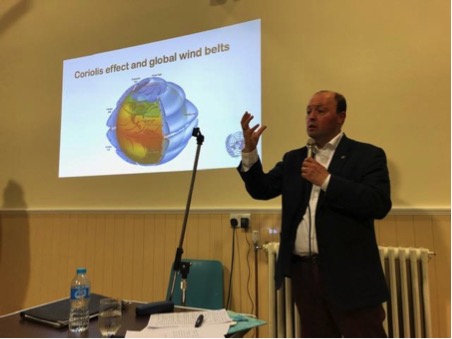
BEXHILL ENVIRONMENTAL GROUP
Environmental Awareness Talk
Climate Change Awareness Talk
The Arctic Ocean
Earth's Climate Controller
HOME PAGE

70 visitors attended the latest climate change awareness talk held by the Bexhill Environmental Group at Beulah Church Hall in Clifford Road on the evening of Wednesday 17th April. The ocean biologist Gonzalo Alverez was invited to explain some of the issues affecting the Arctic from climate change. He emphasized the statement from the United Nations Intergovernmental Panel on Climate Change that says we need urgent global action within the next 12 years to limit climate change and species loss.
The evening began with a viewing of the moving speech made by the Swedish schoolgirl Greta Thunberg to the 2018 EU conference on climate change in Davos.
Gonzalo began to outline concerns held by many for the Arctic. Over two thirds of the Earth is covered by water and 40% of global sea level rise is due to ice melting in the Arctic. He would explain why the apparently pristine sea and ice environments in the Arctic are being affected by climate change. Creatures living in the Arctic have adapted to the specific settled conditions there and developed a balanced food chain. Any change to the Arctic environment may break the balance between the species that live and feed there including moose, caribou, birds, seals, whales and polar bears.
Gonzalo used a series of slides to explain how global winds and ocean currents transfer heat from the tropics to the Arctic. He explained that the lunar gravity, the tilt of the Earth's axis and the Coriolis effect from the Earth spinning on its axis help form the complex wind patterns around the globe. These global winds, including the jet streams, move warmer air from the tropics towards the Arctic. In the Atlantic Ocean, the Gulf Stream brings warmer waters from the Gulf of Mexico towards Europe and the Arctic Ocean and helps maintain the UK's mild climate. Cooler water is returned towards the tropics by other ocean currents including the Labrador Current and the whole circulation moderates the global climate. Warmer ocean currents are less dense so tend to flow near the surface. Cooler ocean currents often flow much deeper because the water is more dense and also contains more nutrients and dissolved carbon dioxide. The oceans are absorbing more carbon dioxide as the concentration in the atmosphere increases. This extra absorption makes the oceans more acidic and this higher acidity poses a risk to life in the ocean. The tropics would be much hotter and the poles much colder if the global winds or ocean currents diminished. It is believed that sea water takes approximately 1000 years to travel the complete cycle through the global ocean conveyor belt, first as a warm surface current from the Atlantic Ocean, through the Indian Ocean to the Pacific Ocean and then returning back again as a cold deep water current.
Sunlight warms the atmosphere much faster than the ocean. However, water has a much higher thermal capacity than the air which cools faster at night than water. The top 3 metres of the world's oceans have the same thermal capacity as the whole of our atmosphere.
Gonzalo explained aspects of the global carbon cycle. Oceans absorb some carbon dioxide especially cold waters. Phytoplankton and plants, including the kelp forests found off our own coasts, convert carbon dioxide for photosynthesis. Geological activity over millions of years has created large stores of carbon underground including coal, oil and gas. While trapped underground, this carbon does not form carbon dioxide gas. However, man has been exploiting and burning these stores of carbon over the last few hundred years, creating large amounts of extra carbon dioxide and increasing the greenhouse gas concentrations in our atmosphere.
Global temperatures are now 1 degree centigrade higher than pre industrial times. The main reason is widely accepted to be the increase in carbon dioxide and other greenhouse gases that magnify the greenhouse effect. This extra global heat is transferred to the Arctic by global winds and ocean currents. Temperatures in the Arctic have increased at almost twice the global rate and have risen by 2 degrees centigrade. These higher temperatures are causing more of the permanent ice cover in the Arctic to melt each year. More Arctic Ocean surface then receives more sunlight which in turn warms the sea even more instead of being reflected away by the ice and snow. Melting Arctic ice is contributing to the global rise in sea level that threatens to flood low lying coastal areas around the globe.
Newly formed snow and ice is pristine and barren of any life. However, over long periods, whole ecosystems develop in the permanent ice in the Arctic. Microscopic organisms including phytoplankton grow and populate the minuscule channels, gaps and holes in the ice. When the ice melts, these organisms enter the Arctic waters and form a rich food source for small fish at the start of the food chain which in turn benefits animals higher up the food chain. If less Arctic ice forms in the future, this reduced food source may affect the whole food chain in the Arctic.
There is concern that the current rate of loss of permanent ice may leave no Arctic sea ice at all in summers after 2040. Creatures that depend on the ice to live and feed will be either threatened or no longer exist in the Arctic. For example, wild polar bears exist only in the Arctic. Their main diet is seal meat which they catch when seals come out of the water. A polar bear cannot catch a seal when swimming in the water so if there is no sea ice they may starve.
The talk concluded with the audience asking well informed questions: proposing how individuals might reduce their carbon footprint, reducing investment in fossil fuels, public protest, voting for candidates supporting environmental policies, concern that plastic waste is found in the Arctic and that other gases contribute to the greenhouse effect.
The evening began with a viewing of the moving speech made by the Swedish schoolgirl Greta Thunberg to the 2018 EU conference on climate change in Davos.
Gonzalo began to outline concerns held by many for the Arctic. Over two thirds of the Earth is covered by water and 40% of global sea level rise is due to ice melting in the Arctic. He would explain why the apparently pristine sea and ice environments in the Arctic are being affected by climate change. Creatures living in the Arctic have adapted to the specific settled conditions there and developed a balanced food chain. Any change to the Arctic environment may break the balance between the species that live and feed there including moose, caribou, birds, seals, whales and polar bears.
Gonzalo used a series of slides to explain how global winds and ocean currents transfer heat from the tropics to the Arctic. He explained that the lunar gravity, the tilt of the Earth's axis and the Coriolis effect from the Earth spinning on its axis help form the complex wind patterns around the globe. These global winds, including the jet streams, move warmer air from the tropics towards the Arctic. In the Atlantic Ocean, the Gulf Stream brings warmer waters from the Gulf of Mexico towards Europe and the Arctic Ocean and helps maintain the UK's mild climate. Cooler water is returned towards the tropics by other ocean currents including the Labrador Current and the whole circulation moderates the global climate. Warmer ocean currents are less dense so tend to flow near the surface. Cooler ocean currents often flow much deeper because the water is more dense and also contains more nutrients and dissolved carbon dioxide. The oceans are absorbing more carbon dioxide as the concentration in the atmosphere increases. This extra absorption makes the oceans more acidic and this higher acidity poses a risk to life in the ocean. The tropics would be much hotter and the poles much colder if the global winds or ocean currents diminished. It is believed that sea water takes approximately 1000 years to travel the complete cycle through the global ocean conveyor belt, first as a warm surface current from the Atlantic Ocean, through the Indian Ocean to the Pacific Ocean and then returning back again as a cold deep water current.
Sunlight warms the atmosphere much faster than the ocean. However, water has a much higher thermal capacity than the air which cools faster at night than water. The top 3 metres of the world's oceans have the same thermal capacity as the whole of our atmosphere.
Gonzalo explained aspects of the global carbon cycle. Oceans absorb some carbon dioxide especially cold waters. Phytoplankton and plants, including the kelp forests found off our own coasts, convert carbon dioxide for photosynthesis. Geological activity over millions of years has created large stores of carbon underground including coal, oil and gas. While trapped underground, this carbon does not form carbon dioxide gas. However, man has been exploiting and burning these stores of carbon over the last few hundred years, creating large amounts of extra carbon dioxide and increasing the greenhouse gas concentrations in our atmosphere.
Global temperatures are now 1 degree centigrade higher than pre industrial times. The main reason is widely accepted to be the increase in carbon dioxide and other greenhouse gases that magnify the greenhouse effect. This extra global heat is transferred to the Arctic by global winds and ocean currents. Temperatures in the Arctic have increased at almost twice the global rate and have risen by 2 degrees centigrade. These higher temperatures are causing more of the permanent ice cover in the Arctic to melt each year. More Arctic Ocean surface then receives more sunlight which in turn warms the sea even more instead of being reflected away by the ice and snow. Melting Arctic ice is contributing to the global rise in sea level that threatens to flood low lying coastal areas around the globe.
Newly formed snow and ice is pristine and barren of any life. However, over long periods, whole ecosystems develop in the permanent ice in the Arctic. Microscopic organisms including phytoplankton grow and populate the minuscule channels, gaps and holes in the ice. When the ice melts, these organisms enter the Arctic waters and form a rich food source for small fish at the start of the food chain which in turn benefits animals higher up the food chain. If less Arctic ice forms in the future, this reduced food source may affect the whole food chain in the Arctic.
There is concern that the current rate of loss of permanent ice may leave no Arctic sea ice at all in summers after 2040. Creatures that depend on the ice to live and feed will be either threatened or no longer exist in the Arctic. For example, wild polar bears exist only in the Arctic. Their main diet is seal meat which they catch when seals come out of the water. A polar bear cannot catch a seal when swimming in the water so if there is no sea ice they may starve.
The talk concluded with the audience asking well informed questions: proposing how individuals might reduce their carbon footprint, reducing investment in fossil fuels, public protest, voting for candidates supporting environmental policies, concern that plastic waste is found in the Arctic and that other gases contribute to the greenhouse effect.